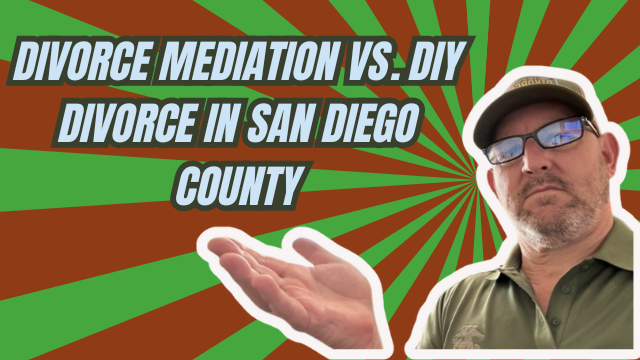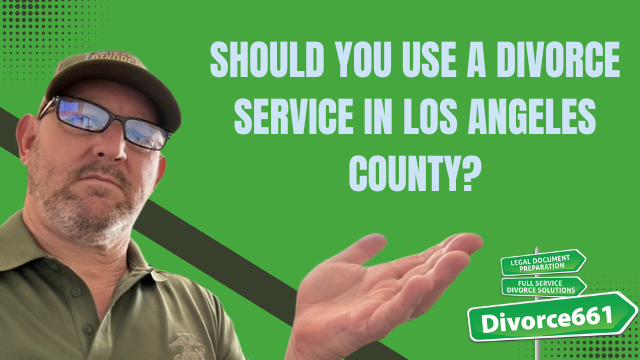Divorce Mediation vs. DIY Divorce in San Diego County
Hi, I’m Tim Blankenship with Divorce661. If you’re getting divorced in San Diego County and want to avoid the courtroom, you may be weighing divorce mediation against a do‑it‑yourself (DIY) divorce. Both options are built for couples who want an amicable resolution, but they serve different needs. This article breaks down how each approach works, when to choose one over the other, and how to get your divorce finalized quickly and affordably.
Quick overview: mediation vs. DIY
- Divorce mediation is a facilitated negotiation led by a neutral third party (the mediator) who helps both spouses reach agreement on custody, support, property division, and other issues.
- DIY divorce focuses on preparing and filing the correct legal paperwork once both parties already agree on the terms. Professional document preparation can make this fast and low cost.
What is divorce mediation?
Mediation is designed for couples who want to avoid litigation but still need help hashing out details. A mediator does not take sides or give legal advice; instead, they guide the conversation, identify issues, and help both parties find common ground.
When mediation makes sense:
- There are unresolved issues that require neutral facilitation (e.g., complex custody schedules, disputed support calculations, or asset valuation).
- Communication between spouses is strained and a neutral presence will keep discussions productive.
- Parties want a collaborative process but need help reaching fair compromises.
Drawbacks of mediation:
- It can be time-consuming and may require multiple sessions.
- Mediation fees add up—often reaching into the thousands of dollars—even when spouses are broadly in agreement.
- It’s not a shortcut if the core issues are already decided; you may be paying for a service you don’t need.
What is a DIY divorce (with professional document preparation)?
A DIY divorce means you and your spouse have already agreed on the major terms and simply need the paperwork prepared and filed correctly. Professional document preparation services (like Divorce661) handle the legal forms, disclosures, settlement agreements, filings, and final judgment—without you having to step foot in court.
When DIY with document preparation is the better option:
- You and your spouse already agree on custody, support, and property division.
- You communicate well and can sign documents together or separately without dispute.
- You want a faster, more affordable path to a court‑approved divorce.
Advantages of this approach include lower cost, speed, and reduced stress. You avoid mediation sessions and attorney billing when they aren’t necessary, while still ensuring everything is done correctly and is court compliant.
How to decide: mediation or DIY?
Ask yourself these questions:
- Do we already agree on the major issues? If yes, DIY with professional document preparation is usually the fastest, most affordable choice.
- Are there unresolved disputes, custody complexities, or strong communication barriers? If yes, mediation may help you reach a fair agreement.
- How much time and money are we willing to invest? Mediation takes more time and typically costs more than professional DIY services.
Decision checklist
- If both parties agree on terms → consider DIY with professional filing.
- If parties need facilitated negotiation or there are complex financial or parenting issues → consider mediation.
- If you started mediation and realize you already agree → stop paying for more sessions and switch to professional document preparation.
Real client story: mediation wasn’t necessary
“After spending over $4,000 in three sessions, they realized they already agreed on everything. They just needed help finishing the paperwork.”
This San Diego couple came to us after several mediation sessions and thousands in fees. Once we stepped in to prepare and file the paperwork, their divorce was finalized in just a few weeks—for a fraction of what they had already paid. That’s a common scenario: mediation can be valuable, but it’s not always the right first step when you already have agreement.
What we handle at Divorce661
We specialize in full‑service, flat‑fee divorce solutions for amicable couples across San Diego County. Our goal is to finish your divorce efficiently and correctly, without court appearances.
Services include:
- Preparing and filing all required forms and documents
- Drafting settlement agreements and disclosures
- Handling service and court filings
- Securing court approval and final judgment
- 100% remote support and a flat fee—no surprise bills
Conclusion and next steps
If you and your spouse are already in agreement, a DIY divorce with professional document preparation is typically faster, simpler, and far less expensive than mediation. If you need help negotiating or there are complex disputes, mediation can be the right path.
For a free consultation and to see whether mediation or a professional DIY approach is best for your situation, visit divorce661.com. We’ll walk you through the process and make sure everything is handled smoothly from start to finish.










